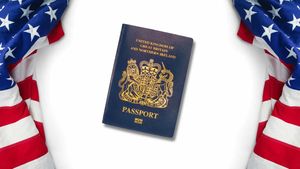The Trump administration has recently unveiled plans to establish a large migrant detention facility at Guantanamo Bay, Cuba, aimed at accommodating as many as 30,000 individuals. This announcement, delivered by President Donald Trump himself, marks another controversial move within his broader immigration strategy.
During a press conference, Trump asserted his directive to the Pentagon and the Department of Homeland Security to prepare the current facility at Guantanamo available for migrants, citing the need to detain what he called "the worst criminal illegal aliens threatening the American people." Trump's bold claim about the prison's capacity to house tens of thousands of migrants has sparked fierce debate about the ethical and logistical viability of such a plan.
Tom Homan, Trump’s chief immigration adviser and former acting director of ICE, later discussed the expansion of the existing facilities, emphasizing the administration's determination to increase the capacity for detaining undocumented migrants. “Today I’m also signing an executive order to instruct the Departments of Defense and Homeland Security to begin preparing the 30,000 person migrant facility at Guantanamo Bay,” Trump stated. He added, “This will double our capacity immediately, right? And, tough.”
While the Guantanamo Bay naval base already houses facilities used for migrants, the recent remark raised questions about the true state of the available infrastructure. Reports indicate there are far fewer beds currently at the facility than the administration claims. An anonymous US official remarked, “There’s no way there’s 30,000 beds anymore” and highlighted the sheer demand for personnel to manage such a large influx.
Historically, Guantanamo Bay has been notorious for its use as a detention facility for suspects of terrorism since post-9/11, with its establishment originally meant for those captured during military operations. The detention center for migrants on the base has been used infrequently over the decades. The facility has previously housed migrants, particularly from Haiti and Cuba, at times of excessive immigration flows, creating rough parallels between past and present strategies employed by the US government.
Cuban President Miguel Díaz-Canel condemned the plan as "an act of brutality," calling attention to the prior controversies surrounding the treatment of detainees at Guantanamo. Human rights advocacy groups have echoed these sentiments, raising alarms about indefinite detentions and proposed conditions for the potential detainees. Many have called for Congress to investigate the claims made about abuses inside this detention facility.
The apprehension surrounding the announcement has been compounded by the challenges of building and implementing operational protocols within the existing migration framework. Critics argue Trump’s administration utilizes fear tactics, equipping the narrative around migrants to label them as threats to national safety. These concerns stretch beyond the legality of detaining migrants to the broader question of humanity and the values the US promotes.
Critics of the plan have also pointed out the failures of the past execution of immigration policies. Data indicated rising fears of economic impact among residents resulted from decisions made over decades, rife with correlation to criminalization narratives directed at immigrants. The handling of past migrant crises leads many to question whether the current approach will yield effective results or if it will falter like its predecessors.
The rumored expedited transportation of migrants to Guantanamo has already begun taking shape as the Pentagon prepares flights, marking the first active phase of Trump's strategy. Reports indicate flights to accommodate these individuals are expected starting this weekend, though significant legal and logistical complications remain unresolved. The actions taken this weekend promise to be an early test of the administration’s commitment to executing this plan, though skepticism looms as officials figure out the next steps.
What remains clear is the intense scrutiny on this move. The looming question is whether the establishment of this massive detention facility will truly address the current immigration issues presented at the southern border or turn out to be another exaggerated endeavor echoing Trump’s controversial border wall plans. For now, as the political battleground surrounding immigration grows ever more contentious, the developments out of Guantanamo Bay warrant watching.



